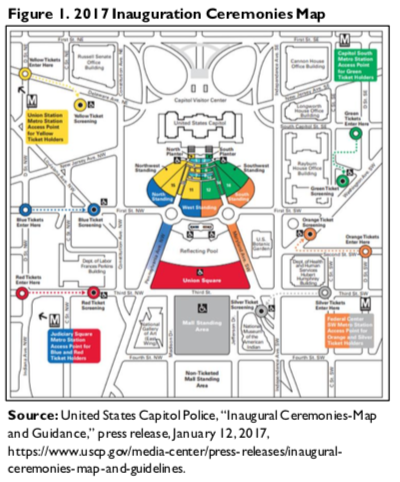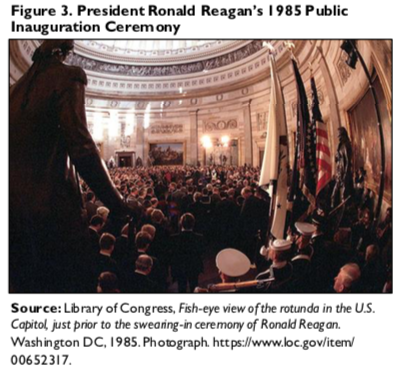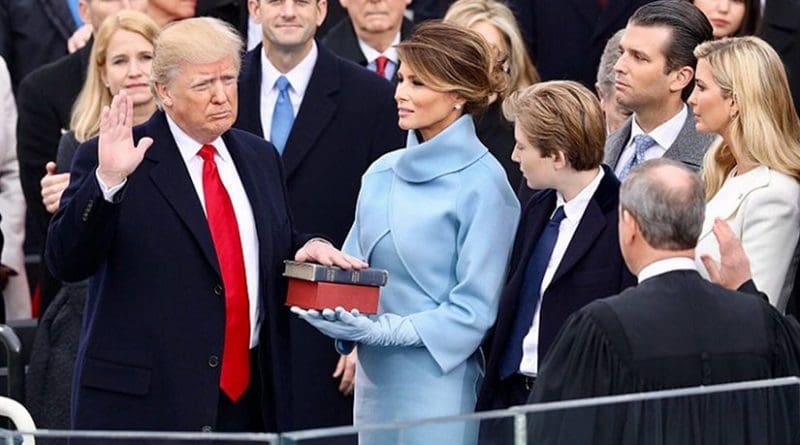US Inaugural Tickets: Past Practices And Considerations For Congress – Explainer
By CRS
By Jacob R. Straus*
Since the 20th Amendment was ratified, the oath of office for President of the United States has been administered every four years on January 20. The next presidential inauguration is scheduled to take place on January 20, 2021.
The move to the West Front of the Capitol not only accommodated larger crowds who could view the ceremony from the Capitol grounds, but also allowed for use of the National Mall. Additionally, the Architect of the Capitol has been able to build a larger platform on the West Front, which in recent years has accommodated more than 1,600 people.
Inaugural Tickets
As the host of the inauguration, the House and Senate jointly appoint the Joint Congressional Committee on Inaugural Ceremonies (JCCIC) every four years. The JCCIC is primarily responsible for arranging and hosting the swearing-in ceremony and hosting an inaugural luncheon.
To accommodate both Members of Congress and constituents who might be interested in attending the swearing-in ceremony in person, the JCCIC has traditionally authorized seated and standing sections on the inaugural platform, the U.S. Capitol grounds, and the National Mall to accommodate attendees. To ease the process of attendees finding their seating or standing locations, the JCCIC and the United States Capitol Police (USCP) have jointly issued a map of ticketed areas showing color-coded sections that correspond to tickets. The map has also included instructions on entering the secured area around the Capitol. Figure 1 shows the 2017 Inauguration Ceremonies Map and Guidelines.

Ticket Allocation
Each inauguration, the JCCIC allocates tickets to congressional offices. Allocated tickets are generally a combination of seated tickets — on the inaugural platform and areas closest to the West Front of the Capitol — and standing tickets, which are often behind the seated tickets.
As depicted in Figure1, in 2017, seated tickets were located on the inaugural platform and in the yellow and green sections. Standing tickets were located in the non-numbered yellow, green, blue, orange, red, and gray/silver areas. Areas beyond these locations were not ticketed and were generally open to the public for viewing on large screens.
Ticket Distribution
Once the JCCIC determines the number of tickets each Member office receives, the Representative or Senator may determine ticket allocation and distribution. For past inaugurations, tickets could not be mailed to recipients and had to be picked up in person. For the 2017 Inauguration, the JCCIC distributed tickets to Member offices on January 9, 2017, and Members generally arranged for ticket pickup between January 17 and 19, 2017.

When allocating tickets, the JCCIC has in the past encouraged Members to create a request and allocation procedure. How offices take ticket requests and decide on allocation has varied, and some Members’ ticket allocation plans have included lotteries from among interested constituents. Tickets distributed to the public are traditionally color coded to correspond to the Inaugural Map issued by the JCCIC and the Capitol Police. Figure 2 shows an example of a ticket issued for PresidentJohn F. Kennedy’s 1961 Inauguration.
Considerations for the 2021 Inauguration
As Inauguration Day draws nearer, in addition to the JCCIC’s ticket allocation and Member offices’ ticket distribution, several other considerations might be relevant for the 2021 Inauguration. These include COVID-19 and security.
COVID-19
The JCCIC has announced that “due to the global pandemic … [it] is committed to traditional, inclusive, and safe ceremonies and will continue to monitor the situation and provide information to all Members as it comes available.” As such, the JCCIC has not issued specific plans for the 2021 Inauguration at this time.
Historically, inauguration plans at times have been adjusted. For example, when January 20 falls on a Sunday, public ceremonies have historically been moved to Monday, January 21, with the President-elect sworn in during a private ceremony at noon on January 20.

Further, in 1985, for President Ronald Reagan’s second inauguration, January 20 fell on a Saturday and the public ceremony was scheduled for the West Front of the Capitol on Monday, January 21. The January 21 ceremony, however, was moved indoors to the Capitol Rotunda because of freezing weather (an estimated 7°F, with a wind chill of -10°F to -20°F at noon, the constitutionally specified time for the beginning of the new presidential term). Figure 3 shows President Reagan’s second public inauguration ceremony in the U.S. Capitol Rotunda.
Security
The USCP, along with the United States Secret Service (USSS) and other federal law enforcement agencies, provides security for the inauguration. The USSS is the lead federal law enforcement agency, as authorized by P.L. 106- 544, and provides security for the President-elect (and current President, for inaugurations involving a transition) and coordinates the event as a National Special Security Event (NSSE), while the USCP provides policing and security for Members of Congress and around the Capitol Building.
For the 2021 Inauguration, USCP has already setup a security perimeter around the West Front of the Capitol in preparation for the swearing-in ceremony. Additionally, on Inauguration Day, streets around the Capitol Complex are generally closed; access to buildings on Capitol Hill, including the U.S. Capitol, is restricted; and staging areas to screen ticketed attendees are set up at strategic locations around the Capitol (see circular dots in Figure1).
Because the details of the 2021 swearing-in ceremony are still unknown and the number of potential attendees has not been determined, adjustments to security arrangements may be made in response to the particular arrangements that are made for the 2021 Inauguration.
*About the author: Jacob R. Straus, Specialist on the Congress
Source: This article was published by CRS (PDF)

